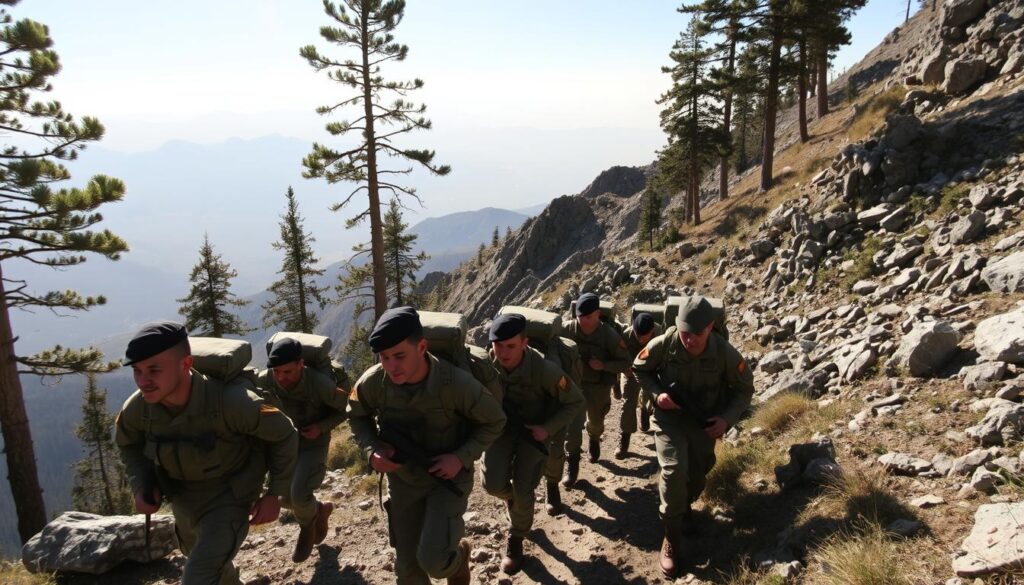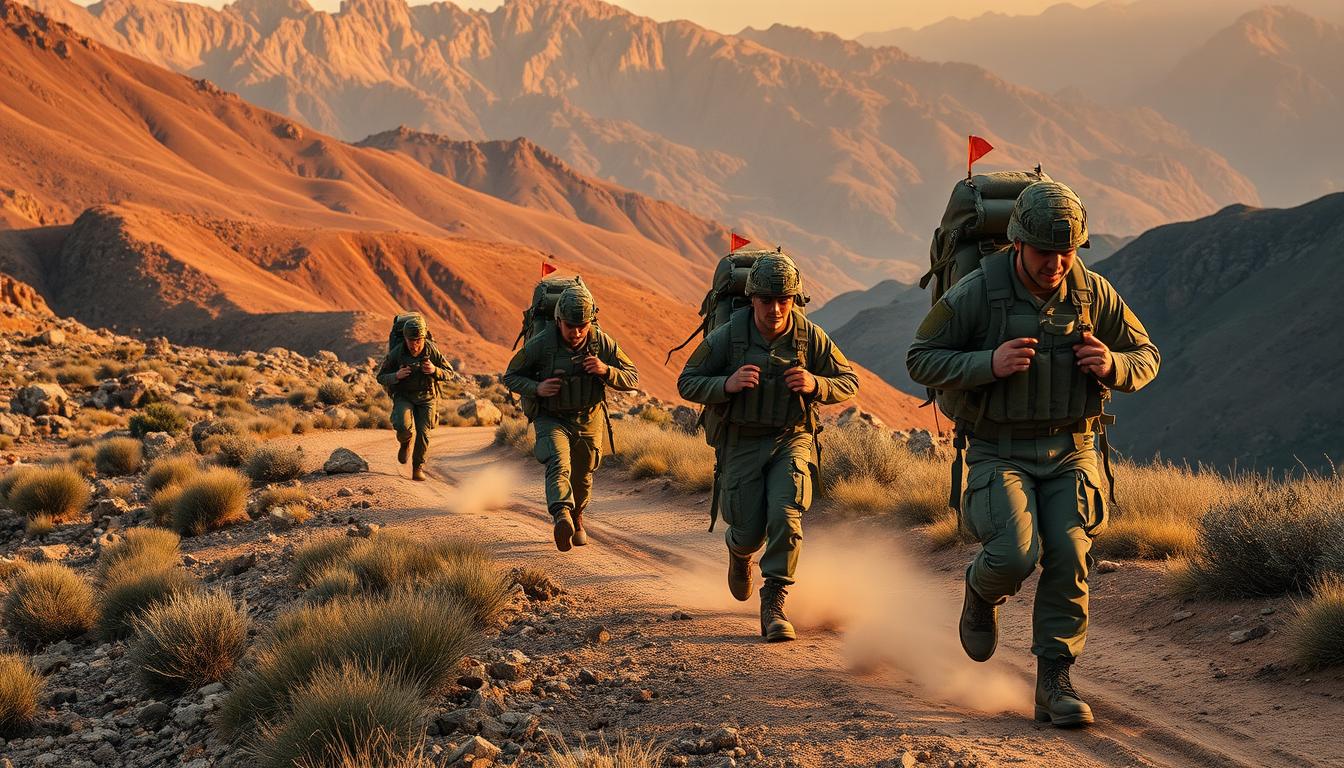Can a tough ruck march change a soldier’s training? For many, it’s a test of endurance, strength, and mental toughness. The 12-mile ruck march is key in military training, pushing soldiers to their limits.
The Army ruck march standards check a soldier’s ability to carry heavy loads far. To get the Expert Infantryman Badge (EIB), candidates must finish a 12-mile march in 3 hours. Knowing these army ruck march regulations is vital for soldiers and those wanting to join the military.
Key Takeaways
- Completing a 12-mile ruck march within 3 hours is required to earn the EIB.
- The ruck march evaluates a soldier’s endurance, strength, and mental toughness.
- Understanding the standards is crucial for military personnel.
- The 12-mile ruck march is a critical component of military training.
- Soldiers must be prepared to carry heavy loads over long distances.
Introduction to Army Ruck March Standards
The Army sets tough standards for ruck marching. This training builds strength, stamina, and character. It’s used by militaries around the world to test recruits.
Importance of Ruck Marching in the Army
Ruck marching is key in military training. It focuses on physical and mental endurance. The 12-mile ruck march is especially important. It shows a soldier’s ability to carry heavy loads over long distances.
This training is vital for combat readiness. It prepares soldiers for tough environments. Ruck marching also boosts discipline, teamwork, and mental toughness. These are crucial for military personnel.

Overview of Ruck March Requirements
The military ruck march requirements are strict. Soldiers must finish ruck marches within set times. They carry packs that meet certain weight standards. For instance, a 35-pound rucksack might be carried over a distance within a time limit.
To pass, soldiers must follow rucking standards. These include:
- Finishing the ruck march on time
- Keeping the right form and technique
- Following safety rules
Meeting these requirements helps soldiers prepare for military life. It ensures they’re ready for challenges.
Physical Fitness Requirements for Ruck Marching
Ruck marching needs a lot of physical fitness, like strength, cardio, and endurance. To do well in a ruck march, soldiers need a good fitness plan.
Army Physical Fitness Test (APFT)
The Army Physical Fitness Test (APFT) is key in military training. It checks if a soldier can handle tough physical tasks. The test has three parts: push-ups, sit-ups, and a 2-mile run. To pass, soldiers must get at least 60 points in each part.
To get ready for the APFT, soldiers should work on their upper body strength, core, and heart health. Doing pull-ups, dumbbell rows, and burpees can help with push-ups and sit-ups.
| Event | Minimum Score | Maximum Score |
|---|---|---|
| Push-ups | 60 | 100 |
| Sit-ups | 60 | 100 |
| 2-mile Run | 60 | 100 |
Recommended Training Regimens
A good training plan is key for ruck marching prep. It should mix strength, cardio, and endurance exercises. For example, training programs that mimic ruck marches are helpful.
Some good exercises include:
- Squats and lunges for leg strength
- Deadlifts for overall strength and endurance
- Planks for core stability
Injury Prevention Strategies
Stopping injuries is very important in ruck marching training. Gradually increase march distances and intensity to avoid injuries. Rest days are also key to prevent fatigue injuries.
Wearing the right gear, like a good rucksack and comfy boots, helps prevent injuries. Staying hydrated and eating well also supports training.

Ruck March Equipment and Gear
Army ruck marching needs the right gear for safety and success. The right equipment boosts a soldier’s performance during a ruck march.
Choosing the Right Rucksack
Finding a comfy and tough rucksack is key for a good ruck march. It should spread the weight evenly, helping soldiers keep a steady army ruck march pace. Look at the material, size, and how it’s suspended when picking a rucksack.
A rucksack that fits well can lower injury risks and boost performance. Soldiers should aim for one with padded straps and a hip belt to move the weight to the hips.
Essential Gear for a Successful Ruck
Along with a great rucksack, soldiers need to carry important gear for a ruck march. This includes water, first aid kits, and extra clothes. The total weight of the ruck, including the army ruck march weight, must meet the standards.
- Water and hydration packs
- First aid kits
- Extra clothing and layers
- Navigation tools and maps
- Emergency shelter and warmth
Hydration and Nutrition Considerations
Staying hydrated and fueled is vital during a ruck march. Soldiers should plan their hydration and nutrition before the march. Drinking water often and eating nutrient-rich foods keeps energy up.
Keeping a balance between drinking water and eating well helps soldiers stay on pace and finish the march.
Army Ruck March Standards for Different Units
Knowing the ruck march standards for different army units is key for good training. Each unit has its own needs based on its mission and operations.
Standard Distances for Ruck Marches
The distances for ruck marches differ among army units. For example, special operations units might march longer with heavier loads than regular infantry.
| Unit Type | Typical Ruck March Distance | Load Requirements |
|---|---|---|
| Conventional Infantry | 5-10 miles | 30-40 lbs |
| Special Operations | 10-20 miles | 50-70 lbs |
| Special Forces | 15-25 miles | 60-80 lbs |
Time Limits and Evaluation Criteria
Time limits for ruck marches are important. They show how ready a soldier is. The criteria include pace, health, and finishing on time.
Evaluation Criteria:
- Completion time
- Physical condition post-march
- Adherence to safety protocols
Variations Between Branches of the Military
While focusing on the army, other military branches also have ruck march standards. For instance, the Marine Corps and Navy SEALs have strict rules for their marches.
The differences between branches show how varied military training is. It’s crucial to know each branch and unit’s specific needs.
Training for Ruck March Success
Getting ready for Army ruck marches is all about good training. A solid training plan is key to success.
Effective Training Programs
A good training plan mixes cardio, strength, and ruck marching. Start with cardio like running or cycling to build endurance.
Strength training is also important. It helps your legs and back get stronger. Try squats, lunges, and deadlifts for this.
Incorporating Strength and Endurance Workouts
Strength and endurance are crucial for ruck march training. Focus on exercises that boost your fitness and stamina.
- Cardiovascular exercises: running, cycling, or swimming
- Strength training: squats, lunges, deadlifts, and leg press
- Core exercises: planks, Russian twists, and leg raises
Adding these workouts to your routine will help you perform better and stay injury-free.
Tips for Practice Rucks
Practice rucks are a big part of Army ruck march training. Here are some tips to enhance your practice rucks:
| Tip | Description |
|---|---|
| Gradual Progression | Slowly add more weight and distance to your rucks to build endurance. |
| Proper Gear | Choose a comfy rucksack and wear the right clothes and shoes. |
| Terrain Variation | Train on different terrains to get ready for the real ruck march. |
By using these tips and a solid training plan, soldiers can boost their chances of success in the Army ruck march.
Conclusion and Resources
Aspiring soldiers can learn a lot from the Army’s ruck march standards. The TRADOC Regulation 672-9 has all the details on the Expert Soldier Badge (ESB) test. This includes the 12-mile foot march.
Key Takeaways for Aspiring Soldiers
To do well in the Army’s ruck march, soldiers need to be in good shape. They must also use the right gear and know the rules. The ESB test is tough, so soldiers need to plan, train, and execute well.
Additional Resources and References
For more info on army ruck march rules and military ruck march needs, check out TRADOC Regulation 672-9. Also, look at other official Army resources. Knowing these rules is key for a successful military career.
Contacting Army Recruiters for More Information
Aspiring soldiers can reach out to Army recruiters for more on the ESB test and ruck march standards. Recruiters can help with prep and training to meet Army standards.

